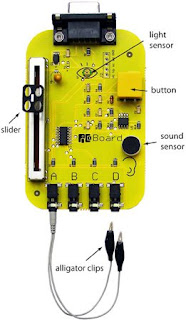 My school bought ten scratch sensor boards (strictly they are called picoboards but can be used with scratch) and I'm in the first week of using them with a new year 10 class. After installing drivers you use the sensor board to control the activities of scratch sprites.
My school bought ten scratch sensor boards (strictly they are called picoboards but can be used with scratch) and I'm in the first week of using them with a new year 10 class. After installing drivers you use the sensor board to control the activities of scratch sprites.The students are really enjoying using them. Actually, it's been one of the most enjoyable introductions to a class I've ever had because the students are fascinated with using the board, motivation is very high and all I have to do is show them how to do new tricks with it.
Here's my introductory worksheet, which is based entirely on this getting started pdf
1) Put a slider for each sensor on the stageMany thanks to Roland Gesthuizen for initially suggesting this and then taking the trouble to send me a sample board to get started with.
How to put different sensors on the stage (slider, light, sound, resistances): Select the sensor type from the drop down menu and then tick the box
2) Display the ScratchBoard watcher
right click on a sensor block > show ScratchBoard watcher
3) Change the way the sprite looks by making noises
4) Make the sprite hop up and down as
a) the light changes (brightness, shadow)
b) as you make noises
c) by moving the slider
5) Make the cat jog on the spot by clapping (the cat has two costumes)
6) Make a sprite spin on the spot by pressing a button
7) Play a drum by touching alligator clips
8) Make a tune by squeezing moist cotton
9) Make an interactive puppet performance (make a puppet, attach alfoil and position alligator clips so they detect arm movement --> use this to create a performance on the stage)
4 comments:
Aren't you guys on summer vacation?
Oh yeah...
Lots of data logging ideas that I haven't yet tried out:
hours of sunshine, cloudcover
classroom lighting (energy conservation)
rainfall sensor
sonar (microphone, speakers and echo)
distance measuring sonar (see XO activity)
with purchase of suitable thermistor:
calibrate thermistor
diurnal temperature
wetbulb & humidity
classroom heating hours (energy conservation)
creek salinity and temperature
log school arrivals with photocell people counter
lots more.
Some great ideas Tony. I must get a few more units to make up a class set at Westall. Lots of interest in Scratch on the study tour.
more ideas at http://wiki.laptop.org/go/Measure
Post a Comment